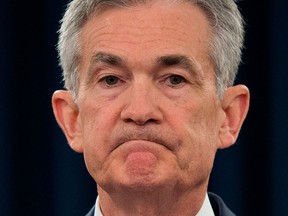
Robert McLister: Spike in bond yields a reminder that Canada does not control its own destiny on rates

Article content
Last December, Bank of Canada governor Tiff Macklem suggested we’d ride an economic rollercoaster on the way back to two per cent inflation. “We can’t rule out bumps along the way,” he warned.
U.S. Federal Reserve boss Jerome Powell sang a similar tune, foreshadowing a “bumpy ride” back to the two per cent target. Yet, for whatever reason, most people either missed the memo or blew off these caveats.
Advertisement 2
Article content
Article content
Lo and behold, we hit another bump on Wednesday, and it wasn’t in Canada. It was south of the border, where U.S. inflation registered a spicy 3.5 per cent, eclipsing forecasts and coming in 0.3 percentage points hotter than the prior month.
That news was a buzzkill for low-rate hopefuls and economists, who expected Wednesday’s BoC meeting to foreshadow rate cuts and lower yields. The central bank indeed reassured us of coming rate relief, but the U.S. CPI drama stole the spotlight.
Uncle Sam’s inflation flare-up and a dud of a bond auction jacked five-year Treasury yields up a staggering 23 bps. Given the cozy link between our countries’ bond markets, soaring U.S. yields dragged Canadian five-year yields 14 basis points higher. It was the biggest spike since October and a reminder that Canada does not control its destiny on mortgage rates.
The fact that our yields follow U.S. yields like an imprinted duckling is not a new problem for borrowers. U.S. and Canadian five-year yields are practically financial BFFs, with a 0.96 correlation (out of 1). So, when U.S. yields take off, they pull a whole wagon of borrowing costs with them, including Canadian fixed mortgage rates.
Article content
Advertisement 3
Article content
Given our mortgage market is hitched to the U.S. star, it begs two questions. First, how likely is it that March U.S. inflation is more than just a bump in the road? And second, how likely is it that Canadian inflation will follow suit?
On inflation
This is the third bounce in U.S. inflation since it started going sideways last summer. Investors are paranoid that it’s more than just a bump, yet they had the same heebie-jeebies in August and December — only for inflation to reverse lower each time.
Looking back in history, inflation rarely falls in a straight line. It’s known for scenic detours that can last from a month to a year-plus. That’s why central banks don’t want us getting too excited about a few months of gloomy data.
Unfortunately, not even the world’s most powerful banker, Jerome Powell, knows if Wednesday’s worrisome inflation data is a bump or a new trend. On more than one occasion, he’s called inflation’s path “highly uncertain,” lamenting how central bankers have little control over externalities like war and surging oil prices.
All that Powell, Tiff Macklem, or any of us can do is wait for more data and hedge some or all of our borrowing costs by locking into today’s rates — if appropriate for our circumstances.
Advertisement 4
Article content
Barring that, we’ve got to trust that high real policy rates do their job. And, so far, they’re working — albeit more so in Canada. The BoC says its core inflation indicators have good downward “momentum.” Fed chief Powell has also been optimistic, but he’ll be less so after Wednesday’s data.
On inflation, it’s worth remembering that the Fed primarily targets the less volatile core PCE inflation, not CPI inflation. And core PCE is already in the two per cent zone stateside — that’s a bit of a comfort blanket.
On the flip side, the Fed’s newer pet indicator‚ “supercore inflation,” which excludes food, energy and housing — zoomed up to an 11-month high of 4.8 per cent. That’s eyebrow-raising territory and far above the two per cent goal.
All that said, unless Canadian and U.S. inflation make a break towards four per cent, the BoC and Fed will ride out these bumps without reaching for the rate-hike lever.
On America’s influence on Canadian CPI
Some of the same forces that spoiled the U.S. CPI party also act on Canada’s inflation rate — think commodity prices, fiscal handouts, wage strength, global supply frictions and so on.
Advertisement 5
Article content
Yet, BoC governor Tiff Macklem said in Wednesday’s press conference that he doesn’t “see a big direct imported inflation effect” from the U.S. That’s essentially because Canada mainly imports American goods, he argues, and goods prices have cooled. The U.S. inflation surge centres more around services, and Canada doesn’t import as much of those.
The Bank of Canada says it has “increased confidence that inflation will continue to come down gradually even as economic activity strengthens.” In fact, it sliced its year-end inflation outlook to just 2.2 per cent. Nail that forecast, and mortgage rates drop — full stop.
That’s a big “if,” of course, but if we take the central bank’s statements at face value and there are no black swans, such as $100-plus oil, there’s reason for optimism. That confidence will grow if Canada’s CPI report doesn’t disappoint on Tuesday.
Recommended from Editorial
As it stands, bond markets are pricing in almost a coinflip’s chance of a cut at the bank’s next meeting on June 5 and a 95 per cent chance by July. Those are good odds, but odds can flip.
For all the mortgage shoppers out there, keep the faith that lower Canadian inflation should pull down mortgage costs later this year. But if you’ve got a mortgage closing in the next 120 days, snag a rate lock regardless — because if we hit more “bumps” in the road, including in the U.S., rates will run temporarily higher.
Robert McLister is a mortgage strategist, interest rate analyst and editor of MortgageLogic.news. You can follow him on X at @RobMcLister.
Article content








